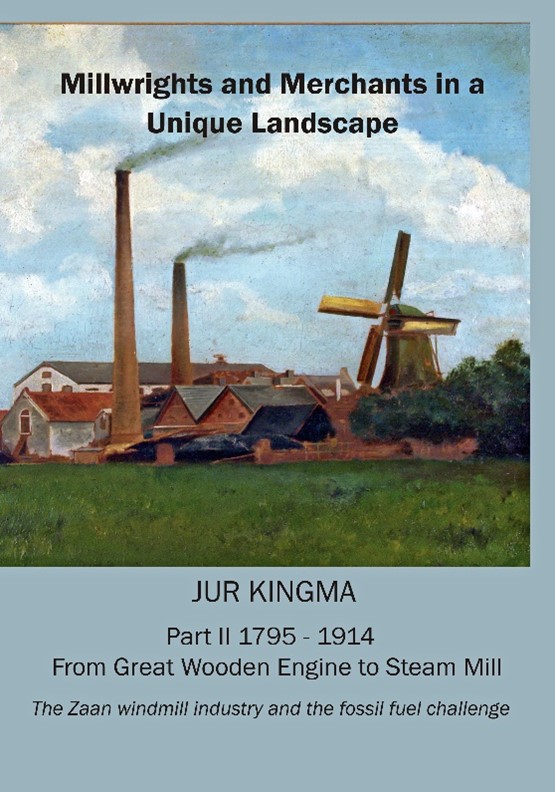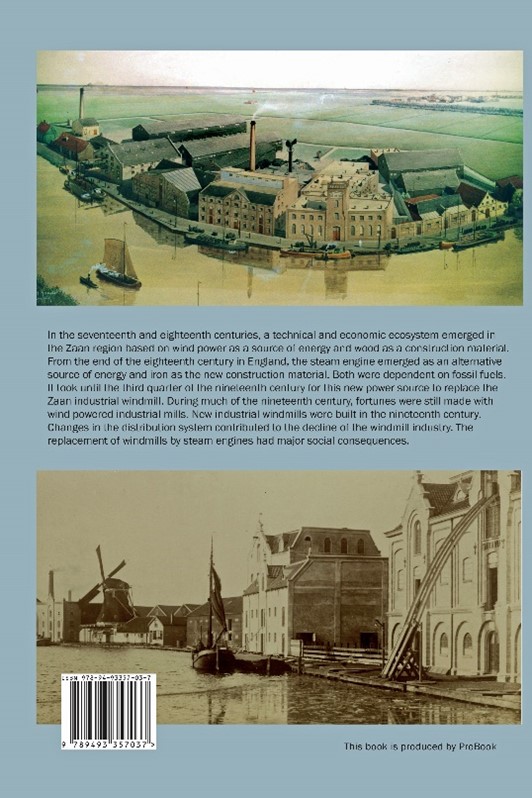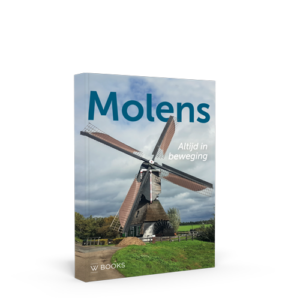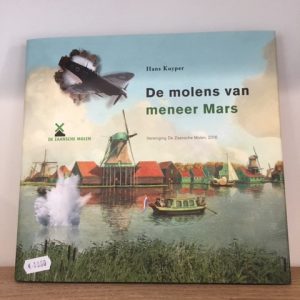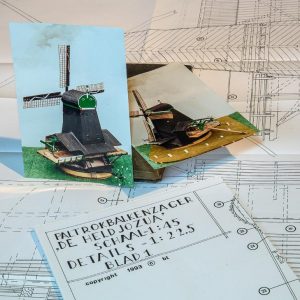Beschrijving
From Great Wooden Engine to Steam Mill
The Zaan windmill industry and the fossil fuel challenge 1795-1914
Part 2 of Millwrights and Merchants in a Unique Landscape
Four and a half centuries of industrial history in the Zaan region
Door Jur Kingma
In the seventeenth and eighteenth centuries, a technical and economic ecosystem emerged in the Zaan region based on wind power as a source of energy and wood as a construction material. From the end of the eighteenth century in England, the steam engine emerged as an alternative source of energy and iron as the new construction material. Both were dependent on fossil fuels. It took until the third quarter of the nineteenth century for this new power source to replace the Zaan industrial windmill. During much of the nineteenth century, fortunes were still made with wind-powered industrial mills. New industrial windmills were built in the nineteenth century. Changes in the distribution system contributed to the decline of the wind mill industry. The replacement of wind mills by steam engines had major social consequences.
More than a quarter century ago I wrote Those Great Wooden Engines: Four Centuries of Industrial Windmills in the Zaanstreek. Research didn’t stop. Since that publication many new discoveries were made by a number of historians. This is part 2 of Merchants and Merchants in a Unique Landscape, Four and a half centuries of industrial history in the Zaan region. The English translation of a book in Dutch from 2019 that summarizes the new insights in the industrial history. There are new chapters, like the social implications of the transition from natural power -wind and water – to power from fossil fuels.
In the original Dutch book the continuity over the centuries was the central theme. In this translated and updated part 2 the discontinuity caused by the introduction of fossil fuels is the main theme. By the successful adaptation to the challenge of the fossil fuels a new level of continuity emerged.
Contents
Chapter 2_1 Introduction The Fossil fuel challengeFout! Bladwijzer niet gedefinieerd.
From wind power tot steam power in the wind and wood technical ecosystem
Chapter 2_2 The changing landscapeFout! Bladwijzer niet gedefinieerd.
New canals, ports, locks and railways as an incentive for trade and industry
Chapter 2_3 From harvesting the wind to fossil fuelsFout! Bladwijzer niet gedefinieerd.
Trial and error in the nineteenth century energy transformation
Chapter 2_4 Hybrid mills, hybrid firms and hybrid industriesFout! Bladwijzer niet gedefinieerd.
The long transitional period to steam power
Chapter 2_5 From mill owners to industrial upper classFout! Bladwijzer niet gedefinieerd.
Transformation of a local political, social and business network
Chapter 2_6 American plantations, Burmese sawahs and the mills of the ZaanFout! Bladwijzer niet gedefinieerd.
The interconnection of the Zaan industrial landscape and world trade
Chapter 2_7 Steam and SocietyFout! Bladwijzer niet gedefinieerd.
From social question to firefighting rows
Chapter 2_8 Adaptations in the technical ecosystemFout! Bladwijzer niet gedefinieerd.
Steam mills and the service industries
Chapter 2_9 The Customer is KingFout! Bladwijzer niet gedefinieerd.
Steam mills and the rise of consumer society
Chapter 2_10 Towards a second Golden AgeFout! Bladwijzer niet gedefinieerd.
New raw materials, new products and new steam mills.
Chapter 2_11 The transformation of the technical ecosystem completedFout! Bladwijzer niet gedefinieerd.
The long nineteenth century: a balance
Monuments of technology and industry in the Zaan region of the 1795-1914 era


